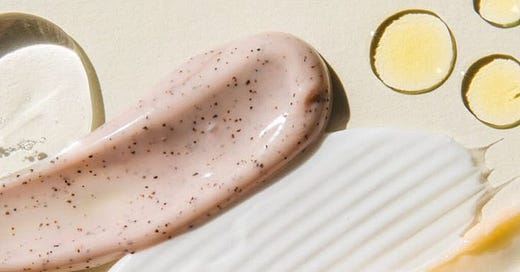I recently discovered that some skincare products contain microplastics as actual ingredients. No, not just through their packaging, literal ingredients that we are rubbing on our skin… Some of our serums, moisturizers, and even cleansers intentionally include microplastics in their formulas.
Beyond the obvious harm they are doing to our health, these microplastics don’t just wash down the drain and disappear. They also end up in our water systems, polluting oceans, harming marine life, and eventually making their way back to us… and killing us further. It’s an environmental AND health concern.
This whole thing honestly makes the journey to balance my hormones feel like an uphill battle.
What Are Microplastics Doing in Skincare???
In beauty products, microplastics can serve several purposes:
• Texture enhancers
• Binding agents
• Exfoliants (especially in older scrubs)
• Film-forming agents that give products that “silky” feeling
They’re used to make a formulas feel smoother, last longer, or look more appealing. But, they don’t actually benefit your skin in any way — just surface level enhancers that are ruining our lives.
How to Spot Microplastics on Your Ingredient List
You won’t explicitly see “microplastic” listed, so here are some names to look out for:
Common microplastic-related ingredients to avoid:
• Polyethylene (PE)
• Polypropylene (PP)
• Polymethyl methacrylate (PMMA)
• Nylon-12 / Nylon-6
• Acrylates Copolymer
• Polyacrylate
• Polyquaternium
• Polyethylene terephthalate (PET)
These don’t always classify as microplastics based on their size and function, but many environmental organizations and clean beauty watchdogs recommend avoiding them altogether.
Tools to Help You Check Your Products
If manually checking the ingredient list feels overwhelming (ditto), here are some tools I’ve been using:
Beat the Microbead app – You can scan a product’s barcode, and it’ll tell you if it contains any known microplastics.
Think Dirty, INCI Decoder, or Yuka – These apps break down ingredient lists and flag harmful or unnecessary additives.
Bonus: I also use Yuka to scan my groceries for harmful ingredients!
Plastic Soup Foundation – They keep an updated list of microplastic-related ingredients that you can cross-reference.
So… What Now?
I’m not saying you should throw everything away immediately — unless you can afford to then please get on it ASAP!
Similar to the closet cleanout, transitioning to non-toxic skincare products is a process that involves a lot of unlearning, cross-checking, and heaps of disappointment. But, this is about progress over perfection. Now that I know better, I can do better. And I want the same for all of us.
So, over the next few weeks, I’ll be diving deeper:
Reviewing my current lineup for hidden microplastics (I’m so scared to unpack this 😖)
Sharing swaps and clean alternatives as I come across them
Skincare shouldn't come at the cost of our health, and frankly, this is all counter intuitive to the goal of having clear skin….
Let me know what you guys think or if there are any additional things you would like me to cover within this topic!




